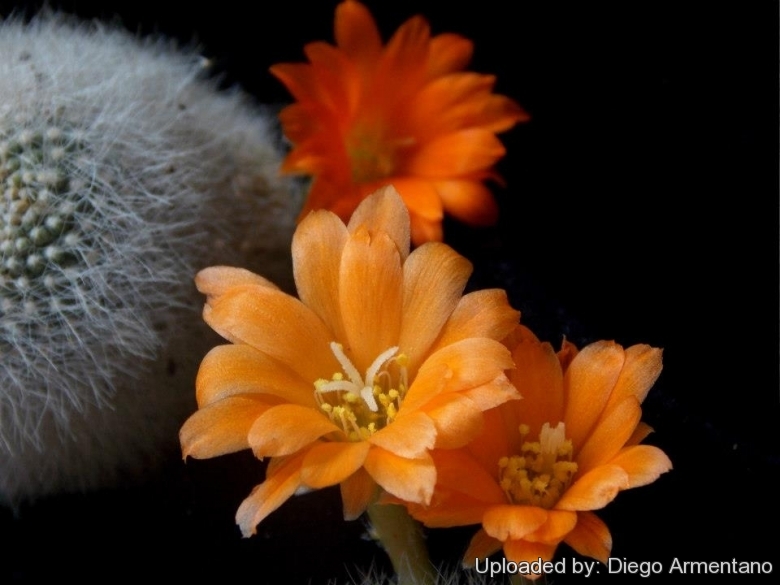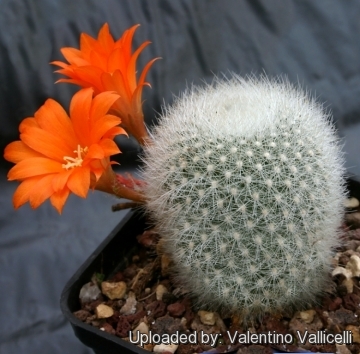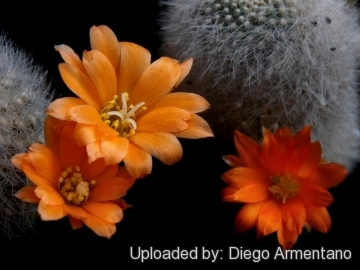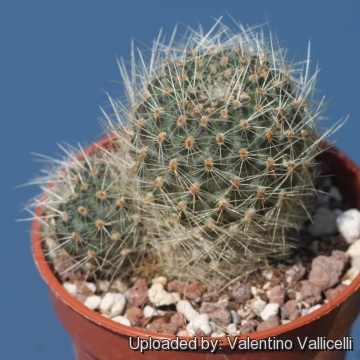Accepted Scientific Name: Rebutia fiebrigii (Gürke) Britton & Rose in L.H.Bailey & L.H.Bailey
Stand. Cycl. Hort. 5: 2915. 1916

Rebutia muscula Photo by: Diego Armentano
Origin and Habitat: Tarija, Bolivia.
Altitude: 1800-3000 metres above sea level.
Habitat: It is found in high, dry, rocky grasslands in rocky slopes of the Andes in fully exposed sites. The dense covering of spines reduces the interception of solar radiation by the stem surface lowering the risks of overheating the apex during a summer day and of freezing during a winter night.
Synonyms:
See all synonyms of Rebutia fiebrigii
back
Accepted name in llifle Database:Rebutia fiebrigii (Gürke) Britton & Rose in L.H.Bailey & L.H.BaileyStand. Cycl. Hort. 5: 2915. 1916Synonymy: 54
back
Common Names include:
ENGLISH: White-haired Crown, Little Mouse, Orange Snowball
Description: Rebutia musculaSN|4985]]SN|4985]] is one of the many geographical forms of the extremely variable Rebutia fiebrigiiSN|4985]]SN|4932]]. The Rebutia musculaSN|4932]]SN|4985]] forms form low cushion covered by dense furry white spines and produces vibrant orange-red flower. The dense spines would protect it from the extremes of cold and sunshine.
Habit: It is a small solitary or mound-forming cactus spreading out to 15 cm. It grows quite close to the ground and offsets only with age. It would appear that in cultivation they grow larger and cluster more vigorously than in habitat.
Roots: Fibrous.
Stem: Hemispherical, later elongated, somewhat depressed at apex, pale green, 3-4 cm wide, 4 cm tall. The stems of this cactus grow usually taller than they are broad. It would appear that in cultivation they grow larger and cluster more vigorously than in habitat.
Ribs: 25-40, with almost square tubercles, about 2 mm high.
Areoles: Short oval, 1-1,5 mm long, on the tops of tubecles, white tomentose, about 3 mm apart.
Spines: About 50 (in cultivation often less, to about 30), bright white, 2-4 mm long, spreading in all directions, fine and soft tightly enveloping the plant body. Central spines hardly distinguishable, somewhat shorter.
Flower: Deep orange, funnel-shaped, up to 3,5 cm long, 2-3 cm in diameter from the base of the stems. Ovary green, with small scales, with with white woolly flakes and about 10 whitish hairy bristles in the axils; Floral tube funnel-shaped about 15 mm long, 3,5 mm wide at the base, above about 5 mm wide, outside light olive green, glossy, green-scaled, with hair and several soft white thin bristle. Tepals, pale reddish orange, about 20 mm long and 5 mm wide, inner ones darker and serrated at the tips, outers more pointed, all widely spread. Filaments whitish, 7-8 mm long, mounted in two series, on the the bottom and the edge of the tube. Anthers yellow. Pistil whitish, with 4-5 yellowish stigma lobes, about 4 mm long, protruding above the highest anthers. There is also a white flowering form.
Blooming Season: Flowers profusely throughout spring into summer with spurts of flowering into autumn.
Fruit: Tiny, berrylike, about 5 mm large, spherical, green-brown, with flowers remnants hidden among the spines, bursting when ripe.
Seeds: Black, about 1,2 mm long, 0,8 x 0,7 mm wide, elongate oval, with a more curved dorsal side, testa with small, tubercles, hilum basal brownish.
Remarks: Rebutia musculaSN|4985]]SN|4985]] is quite variable. The differences usually concern only the spination, along with the more common pure white forms, there are also plants with yellow spines. However the colouring of spines is greatly influenced by the conditions of culture, at lower light levels the spines are less numerous, delicate and white, while with strong solar radiation the spines are stronger with a yellowish tint. Minor differences can also be found in the colour of flowers sometime with a more yellow tint.
Subspecies, varieties, forms and cultivars of plants belonging to the Rebutia fiebrigii group
 Rebutia albipilosa F.Ritter: "White-haired Crown" It is a plant from northern Argentina.The body is made invisible by countless long, soft, hair-like white spines.It produces vibrant orange-red flowers.
Rebutia albipilosa F.Ritter: "White-haired Crown" It is a plant from northern Argentina.The body is made invisible by countless long, soft, hair-like white spines.It produces vibrant orange-red flowers. Rebutia archibuiningiana F.Ritter: The body is made invisible by glassy-white to yellowish, silky, short spines. It produces vibrant orange-red flowers. Distribution: Tarija, Bolivia.
Rebutia archibuiningiana F.Ritter: The body is made invisible by glassy-white to yellowish, silky, short spines. It produces vibrant orange-red flowers. Distribution: Tarija, Bolivia.- Rebutia cintiensis F.Ritter
- Rebutia donaldiana A.B.Lau & G.D.Rowley: "Donald’s Red Crown"n" It develops a dense clump of small, dark heads with brown spines which make a perfect backdrop for the small, dark orange-red, numerous flowers. It quickly begins to form a large, tight mound and it then proceeds to hide it all under a dense blanket of its flowers.
 Rebutia fiebrigii (Gürke) Britton & Rose in L.H.Bailey & L.H.Bailey: "Flame Crown" It’s a Bolivian mountain cactus, found at 3600m altitude, and therefore very hardy. It forms a cylinder about 6cm diameter and 10cm tall with few offsets and it produces striking, flame-red flowers over a long season.
Rebutia fiebrigii (Gürke) Britton & Rose in L.H.Bailey & L.H.Bailey: "Flame Crown" It’s a Bolivian mountain cactus, found at 3600m altitude, and therefore very hardy. It forms a cylinder about 6cm diameter and 10cm tall with few offsets and it produces striking, flame-red flowers over a long season. Rebutia fiebrigii var. azurduyensis (J.de Vries): has yellowish to brownish, silky, short spines and peculiar white blooms. Distribution: Azurduy to La Angostura, Bolivia.
Rebutia fiebrigii var. azurduyensis (J.de Vries): has yellowish to brownish, silky, short spines and peculiar white blooms. Distribution: Azurduy to La Angostura, Bolivia. Rebutia fiebrigii var. densiseta (Cullmann) Oeser: has stronger and very dense brownish spines. Distribution: Chuquisaca, Bolivia.
Rebutia fiebrigii var. densiseta (Cullmann) Oeser: has stronger and very dense brownish spines. Distribution: Chuquisaca, Bolivia.- Rebutia fiebrigii var. vulpes F.Ritter
 Rebutia flavistyla F.Ritter
Rebutia flavistyla F.Ritter Rebutia hoffmannii Diers & Rausch: similar to Rebutia spinosissima, with denser, very fine, tight, white spines, with brownish tips, and outer petals with purple-reddish shades. Distribution: Argentina (Salta) and Bolivia (Tarija).
Rebutia hoffmannii Diers & Rausch: similar to Rebutia spinosissima, with denser, very fine, tight, white spines, with brownish tips, and outer petals with purple-reddish shades. Distribution: Argentina (Salta) and Bolivia (Tarija).- Rebutia ithyacantha (Cárdenas) Diers
- Rebutia jujuyana Rausch
- Rebutia kieslingii Rausch
 Rebutia lateritia n.n.: has brick red flowers. Distribution: Potosi to Ballestro, Bolivia.
Rebutia lateritia n.n.: has brick red flowers. Distribution: Potosi to Ballestro, Bolivia. Rebutia muscula F.Ritter & Thiele: "Little Mouse" It comes from south Bolivia; it is distinguished by its soft white spination and orange flowers and it blooms heavily in May, continuing until September/October with always at least a few flowers. It is especially desirable for the small size of its main body, with the offsets held closely, usually in a pattern reminiscent of a classical sculpture.
Rebutia muscula F.Ritter & Thiele: "Little Mouse" It comes from south Bolivia; it is distinguished by its soft white spination and orange flowers and it blooms heavily in May, continuing until September/October with always at least a few flowers. It is especially desirable for the small size of its main body, with the offsets held closely, usually in a pattern reminiscent of a classical sculpture. Rebutia narvaecensis (Cárdenas) Donald: has 10-30 thin, needle-like whitish to yellowish pines, 2-5 mm long, and numerous pale pink flowers. Distribution: Bolivia. Narvaez (Department of Tarija, O'Connor Province)
Rebutia narvaecensis (Cárdenas) Donald: has 10-30 thin, needle-like whitish to yellowish pines, 2-5 mm long, and numerous pale pink flowers. Distribution: Bolivia. Narvaez (Department of Tarija, O'Connor Province) Rebutia pulchella Rausch
Rebutia pulchella Rausch Rebutia pulchella var. prolifera Rausch
Rebutia pulchella var. prolifera Rausch Rebutia simoniana Rausch
Rebutia simoniana Rausch Rebutia sp. Huari Huari
Rebutia sp. Huari Huari Rebutia vallegrandensis Cárdenas
Rebutia vallegrandensis Cárdenas
Bibliography: Major references and further lectures
1) Edward Anderson “The Cactus family” Timber Press, Incorporated, 2001
2) James Cullen, Sabina G. Knees, H. Suzanne Cubey "The European Garden Flora Flowering Plants: A Manual for the Identification of Plants Cultivated in Europe, Both Out-of-Doors and Under Glass" Cambridge University Press, 11/Aug/2011
3) David R Hunt; Nigel P Taylor; Graham Charles; International Cactaceae Systematics Group. "The New Cactus Lexicon" dh books, 2006
4) Curt Backeberg “Die Cactaceae: Handbuch der Kakteenkunde” Gustav Fischer Verlag, Stuttgart New York 1982–1985
5) Backeberg, Curt; "Descriptio Cactacearum Novarum", 3: 5, 1963
6) Backeberg, Curt; "Das Kakteenlexikon" p. 70, 1966
7) Donald, John Donald; "Cactus & Succulent Journal of GB", 27: 78, 1965
8) Donald, John Donald; "Ashingtonia", 2:181, 1975
9) Haage, Walter; "Kakteen von A bis Z", p. 44, 1981
10) Pilbeam, John; "Rebutia" (ISBN 0-9528302-2-1), p. 76, 1997
11) Ritter, Friedrich; "Kakteen in Südamerika", 2: 618, 1980
12) Šída, Otakar; "Rod Rebutia" (ISBN 80-901383-5-7), p. 60, 1997
13) Veverka, Miroslav; "Atlas kaktusů", tab. 41, 1995
14) Lowry, M. 2013. Rebutia fiebrigii. The IUCN Red List of Threatened Species. Version 2014.3. <www.iucnredlist.org>. Downloaded on 28 April 2015.
15) N. L. Britton, J. N. Rose “The Cactaceae. Descriptions and Illustrations of Plants of the Cactus Family.” Volume 4, The Carnegie Institution of Washington, Washington 1923
 Rebutia muscula Photo by: Valentino Vallicelli
Rebutia muscula Photo by: Valentino Vallicelli Rebutia muscula Photo by: Diego Armentano
Rebutia muscula Photo by: Diego Armentano White flowering form. Photo by: Colin Bundred
White flowering form. Photo by: Colin Bundred HS202 (Collector Heinz Swoboda) Tarija to Iscayachi, Cuesta de Sama, Mendez, Tarija, Bolivia. Photo by: Valentino Vallicelli
HS202 (Collector Heinz Swoboda) Tarija to Iscayachi, Cuesta de Sama, Mendez, Tarija, Bolivia. Photo by: Valentino VallicelliCultivation and Propagation: Rebutia musculaSN|4948]]SN|4985]] is a summer grower species that is easy to cultivate and recommended for beginners. The whole Rebutia fiebrigiiSN|4932]]SN|4932]] complex has delightful flowers and the plants remain compact, and clumps can easily be managed by division. Another advantage is that the plants are cold hardy in winter if kept dry.
Growth rate: It is a slow growing but easily flowering species that will make clumps given the best conditions.
Soils: This species is easy to cultivate in a very open mineral mix with at least 50% sand or pumice grit and a pH slightly on the acidic side.
Repotting: It is better that they are repotted regularly. Pots should be only slightly larger than the plant and root system. Repotting will increase the number and size of stems, and will increase the number of flowers produced. Repot yearly until they reach about 100 mm in size, then every two or three years will suffice. Repotting is best done at the end of winter, but can be done at other times, too. Do not water for a couple of weeks after repotting, to reduce risk of root rot via broken roots. A layer of 'pea' gravel at the bottom of the pot improves drainage. A layer of decorative gravel as a top dressing helps prevent the caking of the potting mix, which decreases the rate of water absorption. It also keeps the perlite and pumice from blowing everywhere, and looks nice.
Watering: It requires full sun or light shade and careful watering to keep plant compact, and maintain strong and dense spines and allow the pot to dry out between waterings. Keep dry in winter at a minimum temperature of 0°C. Rebutia albipilosaSN|4985]]SN|4948]] tends to rot if too wet. The plants can be placed outdoors in April, but protected from rain and direct sunlight. Water them thoroughly when placed out, and again in two weeks, and again in one week. After one month the plants are ready to be placed out in full sun and full rain for the summer. During dry spells the collection is watered once a week, during hot dry spells, twice a week.
Fertilization: Feed with a high potassium fertilizer in summer.
Hardiness: It is reputedly resistant to frost if kept on the dry side prior to, and during, cold weather and requires a winter rest period (hardy to -7° C, or less for short periods). Rebutias grow in nature at high altitudes, and do not thrive well at high temperatures in cultivation. They will often go dormant in mid-summer, and resume growth again when the weather cools in late August. They can tolerate amazingly low temperatures for long periods of time. All species can take a frost, even when not bone dry. It is generally accepted that plants kept at too high a temperature, or watered too much during the winter rest period, will not bloom the following year. They will be perfectly happy in pots outdoors from April to September if protected from torrential rain and hail.
Exposition: The plant tolerates extremely bright situations but enjoys filtered sunlight or afternoon shade, inside it needs bright light, and some direct sun. Tends to bronze in strong light, which encourages flowering and heavy spine production, but is likely to suffer from sun scorch or stunted growth if over exposed to direct sunlight during the hottest part of the day in summer.
Uses: It is an excellent plant for container growing. It always looks good and stays small. It look fine in a cold greenhouse and frame or outdoor in a rockery.
Pests & diseases: All, especially the young, are susceptible to red spider mites.
Rot: This species is particularly easy and accommodating, seldom suffer of cryptogamic diseases. Rot it is only a minor problem with rebutias if the plants are watered and “aired” correctly. If they are not, fungicides won't help all that much.
Propagation: Offsets, seeds. Seeds germinate in 7-14 days at 21-27° C in spring, remove gradually the glass cover as soon the plants will be well rooted (ca 1-2 weeks) and keep ventilated, no full sun for young plants! To make a cutting twist off a branch and permit it to dry out a couple of weeks, lay it on the soil and insert the stem end partially into the soil. Try to keep the cutting somewhat upright so that the roots are able to grow downward.
Note: It would appear that in cultivation they grow larger and cluster more vigorously than in habitat.














